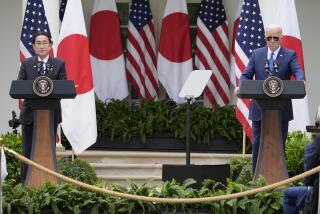U.S. Asks Japan to Participate in $8-Billion Supercollider Project
- Share via
TOKYO — Japan has been asked to make participation in an $8-billion superconducting supercollider “a symbol of the global partnership” that President Bush has offered Prime Minister Toshiki Kaifu, W. Henson Moore, deputy energy secretary, said Monday.
After holding formal talks with Japanese officials Monday, Moore added that the Bush Administration would be willing to raise the ceiling on foreign participation of one-third, or $2.6 billion, of the projected cost of the massive project if Japan and other countries wanted to make a larger investment. The House has authorized the $2.6-billion level of investment but the Senate has not yet acted.
“We in the U.S. government would prefer to receive that amount and are even willing to discuss a greater amount,” he said.
“Due to the size of this project, it will not be possible to build it with U.S. funding only. It’s too big for any one country. It needs to be an international project. . . ,” Moore said.
The U.S. government is planning to finance up to $5 billion of the cost and the state of Texas has shouldered a $1-billion burden. A 54-mile underground tunnel is to be built around the small town of Waxahachie, Tex., near Dallas, in which streams of protons, guided by powerful superconducting magnets, will be shot at nearly the speed of light to collide against each other. This will enable physicists to learn more about the nature of matter and energy.
Moore said he has high hopes that Japan will join the project “because it wants to give meaning to the agreement between President Bush and Prime Minister Kaifu to make the U.S.-Japan relationship a global partnership.” He added that the U.S. government also believes that Japanese participation would “give meaning and life to a global partnership.”
The Energy Department official refused to disclose how much money he asked Japan to contribute but emphasized that the United States wants Japan to be a full partner in the project. Nor did he reveal how Japanese officials responded to his invitation.
The next step, if Japan decides to take it, “would be for the Japanese government to send a team of officials and scientists to the United States to go into more detail on how the project will look,” he told a new conference shortly before leaving for Seoul. There, his team will invite the South Korean government to join the project.
“There are no limitations . . . at present” concerning what companies might build 8,150 of the 12,000 magnets that will go into the supercollider, he said. Japanese firms are reported to be interested in bidding to build the magnets, which will cost about $1 billion.
Apart from considerations of cost, some Japanese political leaders are reportedly worried that if they decide to take part, American critics might complain about a giveaway of American technology. Others fear that a decision not to join will be attacked as a sign of a Japanese desire to benefit scientifically, once the projects’ results are released, without bearing a monetary burden.
More to Read
Sign up for Essential California
The most important California stories and recommendations in your inbox every morning.
You may occasionally receive promotional content from the Los Angeles Times.












